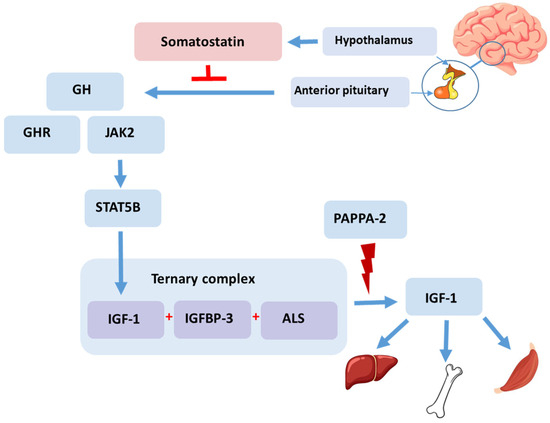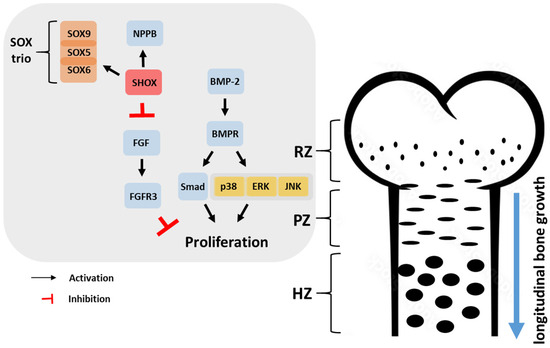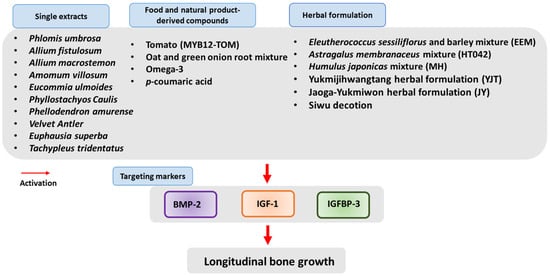You're using an outdated browser. Please upgrade to a modern browser for the best experience.
Please note this is a comparison between Version 1 by Dong Wook Lim and Version 2 by Lindsay Dong.
Several herbal formulations based on traditional medicine have the potential to improve bone growth, although their effectiveness is controversial. It was confirmed that the majority of extracts containing herbal formulations were orally administered over a short period, ranging from 4 to 10 days during the experimental phase.
- longitudinal bone growth
- idiopathic short stature
- growth plate
- chondrogenesis
- natural products
1. Introduction
Idiopathic short stature (ISS) is defined as an individual’s height below the 3% relative to the average height for the given age without finding any specific environmental, nutritional or genetic abnormality [1]. Approximately 80% of children with short stature are presented as having ISS [2]. The treatment with recombinant human growth hormone (rhGH) for ISS was approved by the Food and Drug Administration (FDA) in the United States in July 2003, and the current FDA-approved doses for GH in ISS are up to 0.30–0.37 mg/kg per week [3]. rhGH treatment increases the growth rate in the first year, but its effect on final height for 5 years is controversial [4]. Given that it requires daily parenteral administration, and its cost remains prohibitive in many parts of the world, a new strategic approach is needed [5]. Recently, efforts have been made to explore therapeutic alternatives that would facilitate slower bone maturation and more prolonged spontaneous or induced growth. Treatment options, such as aromatase inhibitors, gonadotropin-releasing hormone analogues (GnRHas), and recombinant human insulin-like growth factor-1 (rhIGF-1), have been employed to address ISS [6].
2. The Growth Hormone (GH)–Insulin-like Growth Factor (IGF) Axis
Although ISS does not present with any specific environmental, nutritional, or genetic abnormality, it is necessary to approach it from the perspective of genetic defects in the somatotropic axis. The somatotropic axis, also known as the GH–IGF axis, is composed of GH, IGFs, related carrier proteins, and receptors (Figure 1). It plays an important role in regulating metabolic and physiological processes, including bone growth [7][13]. Some patients with ISS show abnormalities in the somatotropic axis, indicating GH insensitivity [8][14]. GH is primarily regulated by the interaction of two peptide hormones: GH-releasing hormone, which stimulates the secretion of growth hormone, and somatostatin, which inhibits GH secretion from the hypothalamus [9][15]. GH binds to a GH receptor (GHR), which activates JAK2 (Janus Kinase 2) and promotes the phosphorylation of various members of the signal transducer and activator of transcription family (STAT5B). This process primarily stimulates IGF-1. IGF-1, a single-chain polypeptide, is a growth-promoting polypeptide that is essential for normal growth and development [10][16]. IGF-1 is closely related to the GH level and plays a crucial role in promoting the growth and development of bones, particularly in the growth plates [11][17]. It has been reported that children with ISS might exhibit lower IGF-1 levels compared to the average values observed in healthy children [12][18]. The growth plate, also known as the epiphyseal plate, is a specialized cartilaginous region at the ends of long bones where bone growth occurs during childhood and adolescence [13][19]. IGF-1 circulates in the bloodstream, primarily bound to IGF-binding protein-3 (IGFBP-3) and acid-labile subunit (ALS), forming a ternary complex (IGF-1/IGFBP-3/ALS) [14][20].
Figure 1. Growth hormone–insulin-like growth factor-1 axis. GH binds to a GHR, which activates JAK2 and promotes the phosphorylation of various members of the STAT5B protein family. This process primarily stimulates the production of IGF-1. IGF-1 circulates in the bloodstream, primarily bound to IGFBP-3 and ALS, forming a ternary complex. PAPPA-2 proteolyzes IGFBP-3, increasing the bioavailability of IGF-1. As the ternary complex reaches the growth plate, it interacts with specific IGF-1 receptors located on the surface of chondrocytes, which are responsible for bone growth. GH: growth hormone, GHR: growth hormone receptor, JAK2: Janus kinase 2, STAT5B: signal transducer and activator of transcription 5B, IGF-1: insulin-like-growth factor 1, IGFBP-3: IGF-binding protein-3, ALS: acid-labile subunit, PAPPA-2: Pregnancy-associated plasma protein-2.
3. Regulator of Growth Plate Chondrogenesis
The growth plate, comprising the resting zone (RZ), proliferative zone (PZ), and hypertrophic zone (HZ), is a crucial structure involved in bone development [15][23]. According to previous reports on the mechanistic pathways of human height growth [16][24], chondrocytes in the RZ are irregularly distributed within the cartilage matrix layer, while those in the PZ and HZ align in columns parallel to the bone’s long axis. The RZ acts as a reservoir of precursor cells that support growth plate maintenance and contribute to bone growth. The PZ plays a crucial role in endochondral bone formation as it hosts active cell replication. Similarly, the HZ consists of chondrocytes derived from the terminal differentiation of PZ chondrocytes located the farthest from the epiphysis. These hypertrophic chondrocytes cease dividing and undergo significant enlargement, making substantial contributions to the overall growth process (Figure 2).


Figure 2. Bone growth and mechanism of FGF and SHOX on growth plate chondrogenesis. The RZ stores the precursor cells supporting growth plate maintenance and bone growth. The PZ is crucial for active cell replication in endochondral bone formation. The HZ contains large, non-dividing chondrocytes contributing significantly to overall growth. SHOX stimulates chondrocyte proliferation and differentiation by activating NPPB, inhibiting FGFR3 expression, and interacting with the SOX trio (SOX9, SOX5, and SOX6) for cartilage matrix production. FGFR3 negatively impacts growth plate chondrogenesis. RZ: Resting zone, PZ: Proliferative zone, HZ: Hypertrophic zone, BMP-2: Bone morphogenetic protein-2, BMPR: Bone morphogenetic protein receptor, p38: p38 MAP kinase, ERK: extracellular signal-regulated kinase, JNK: c-Jun NH2-terminal kinase, NPPB: Natriuretic peptide precursor B gene, SHOX: Short stature homeobox, FGF: Fibroblast growth factor, FGFR3: Fibroblast growth factor receptor 3.
4. Animal Models for Studying the Effect of Longitudinal Bone Growth
Hypophysectomy was performed in rats to establish an animal model of growth hormone deficiency [17][31]. Evidence from animal models shows that hypophysectomy in rats significantly decreased body weight, tail length, and bone lengths, as well as bone mineral density. These results improved to normal levels with the treatment of growth hormone through daily injections of 0.25 mg/kg of rhGH [18][32]. However, hypophysectomy also renders the animals deficient in other growth-regulating hormone systems. Therefore, GH deficiency produced by hypophysectomy may not be the ideal model to study the growth effects of hormone replacement strategies [19][33].

5. Natural Products-Derived Extracts, including Herbal Formulations, for Short Stature
Multiple studies have demonstrated that changes in bone growth-related biomarkers, such as IGF-1, BMP-2, and IGFBP-3, contribute significantly to the development of longitudinal bone growth. Therefore, targeting these markers through the regulation of growth hormone has been proposed as a therapeutic strategy for the treatment of ISS [20][36]. Many natural products, including herbal formulations, have been found to exert enhancing effects on longitudinal bone growth in animal models by increasing IGF-1, BMP-2, and IGFBP-3 levels in both the serum and tissue-sectioned growth plates. These studies suggest that natural products may enhance longitudinal bone growth by regulating IGF-1. Figure 3 present a summary of the natural products that have been found to possess the potential to alleviate longitudinal bone growth.
Figure 3. Effect of natural products, including of herbal formulations, on longitudinal bone growth by the activation of growth hormone-mediated biomarkers in animal models. Natural products may enhance longitudinal bone growth by regulating BMP-2, IGF-1, and IGFBP-3. IGF-1: Insulin-like-growth factor 1, IGFBP-3: IGF-binding protein-3, BMP-2: Bone morphogenetic protein-2.
5.1. Eleutherococcus sessiliflorus and Barley Mixture (EEM)
E. sessiliflorus is a medicinal herb with a range of biological effects, including anti-inflammatory, anti-cancer, antioxidant, and anti-obesity properties [21][37]. Barley (Hordeum vulgare) stands out as one of the most crucial crops globally. Barley has been demonstrated to effectively remove superoxide anion radicals [22][38]. In vivo experiments have confirmed that EEM, a standardized mixture of these two components, E. sessiliflorus and barley, promotes bone length growth in rats [23][39].
